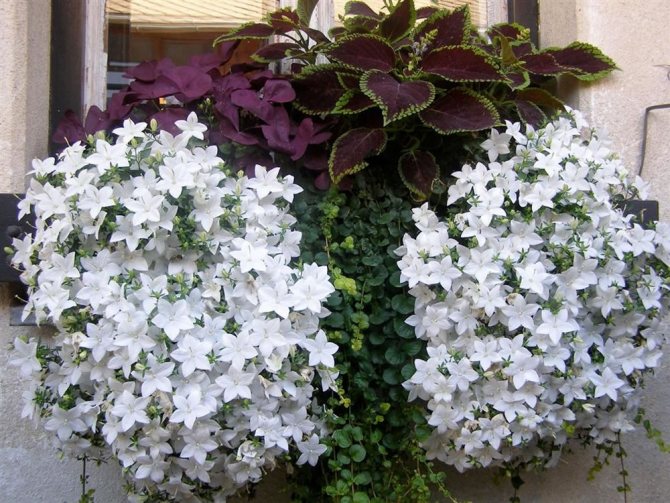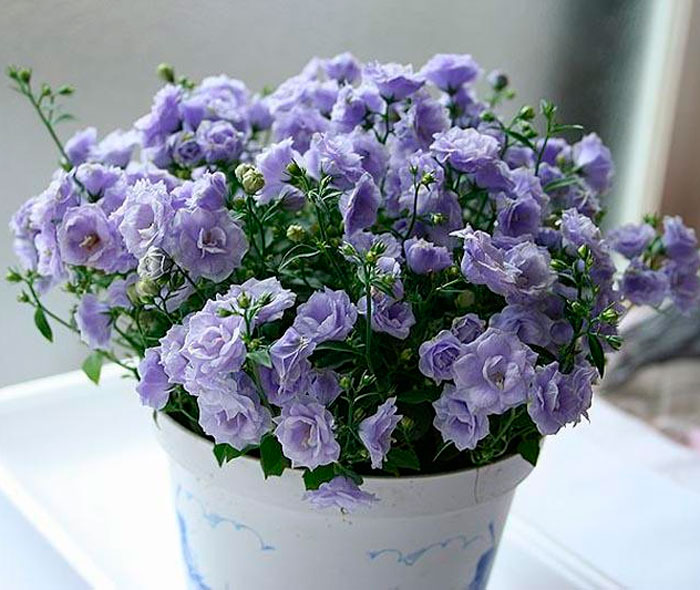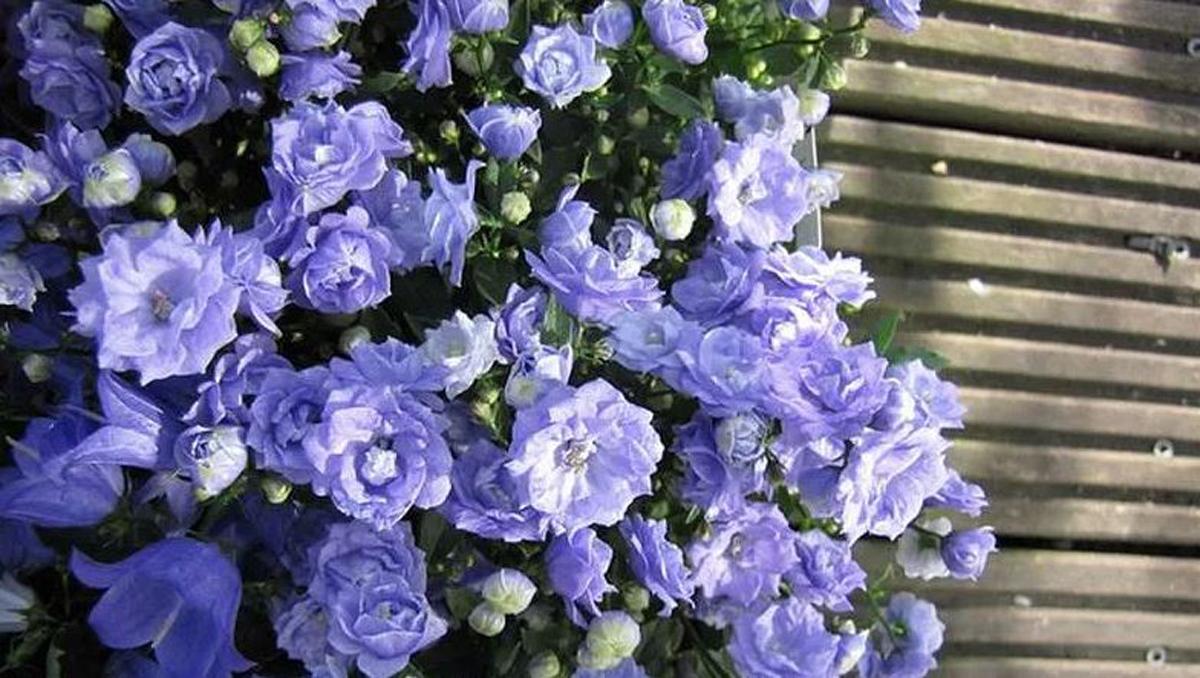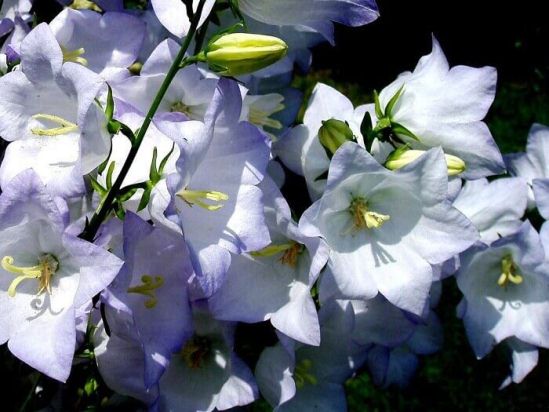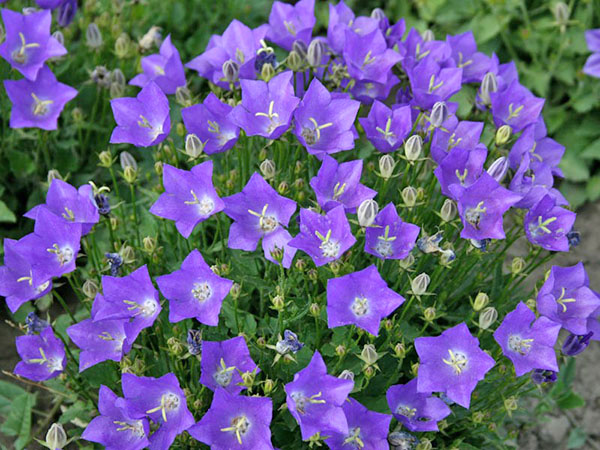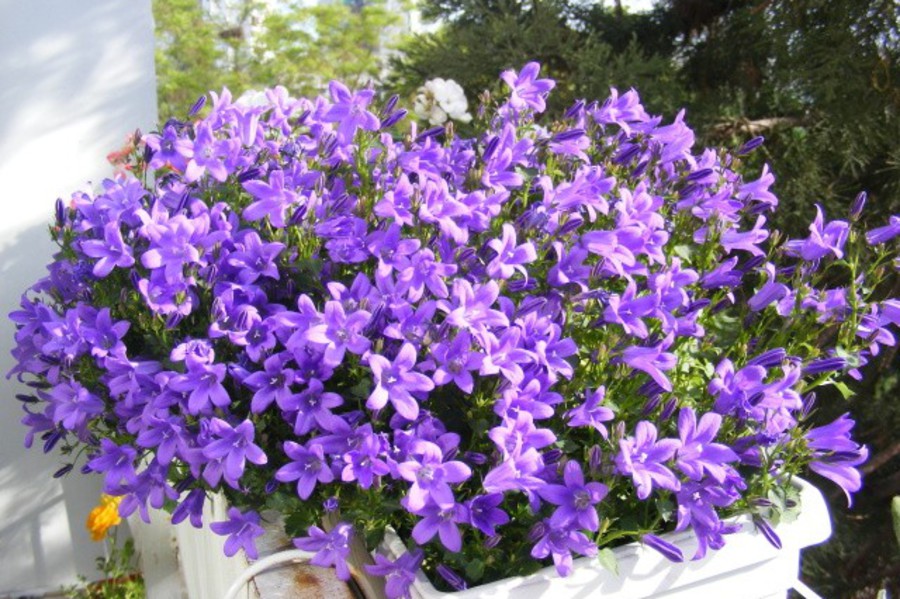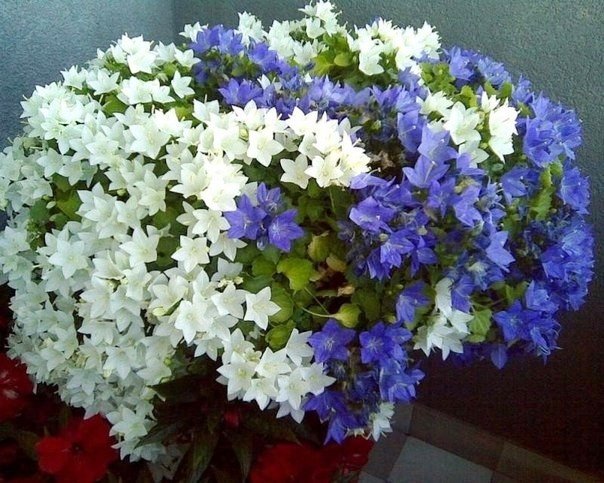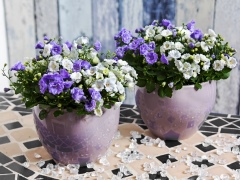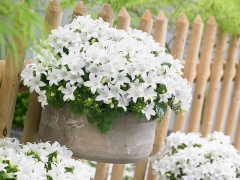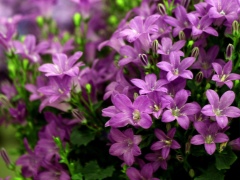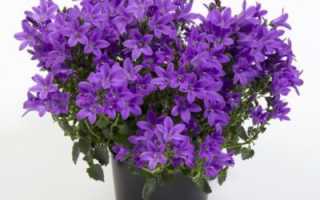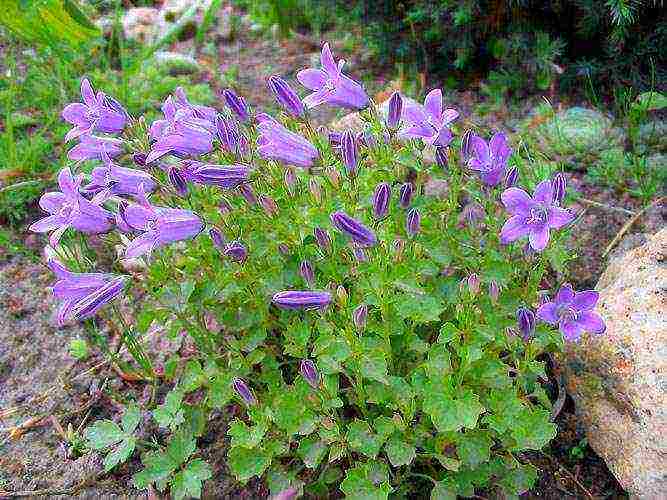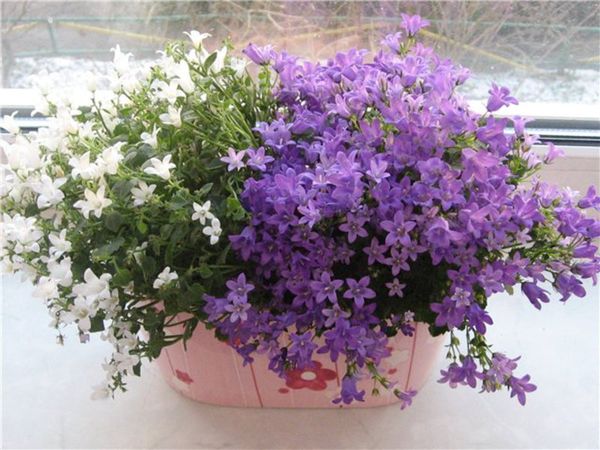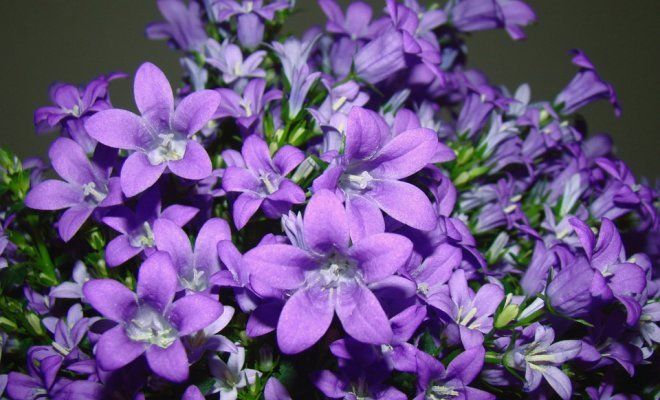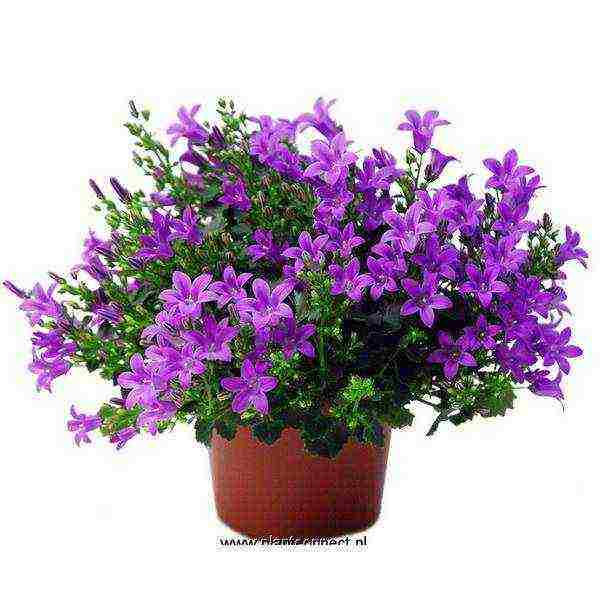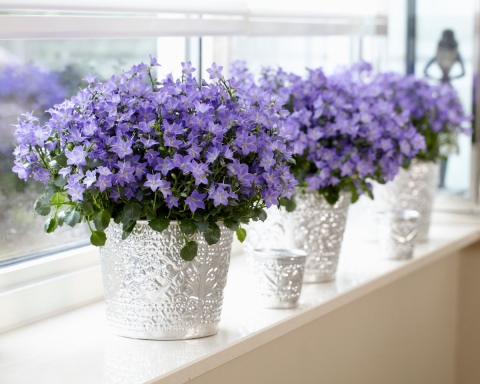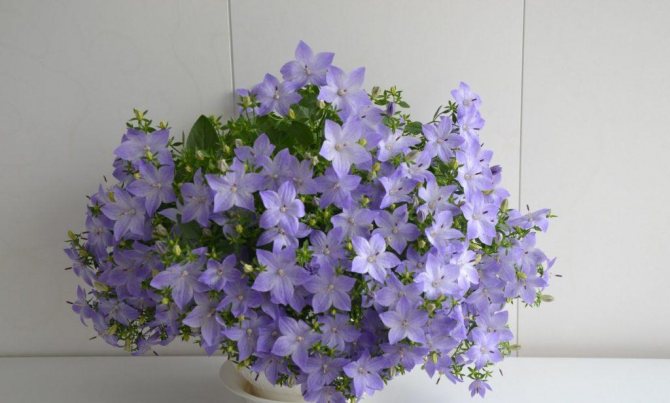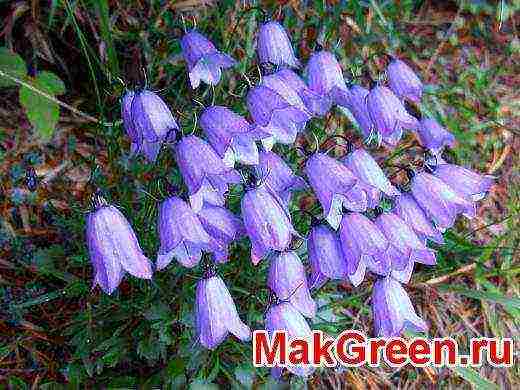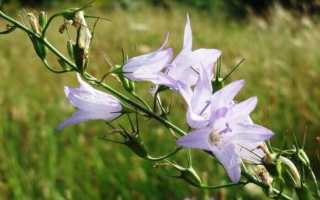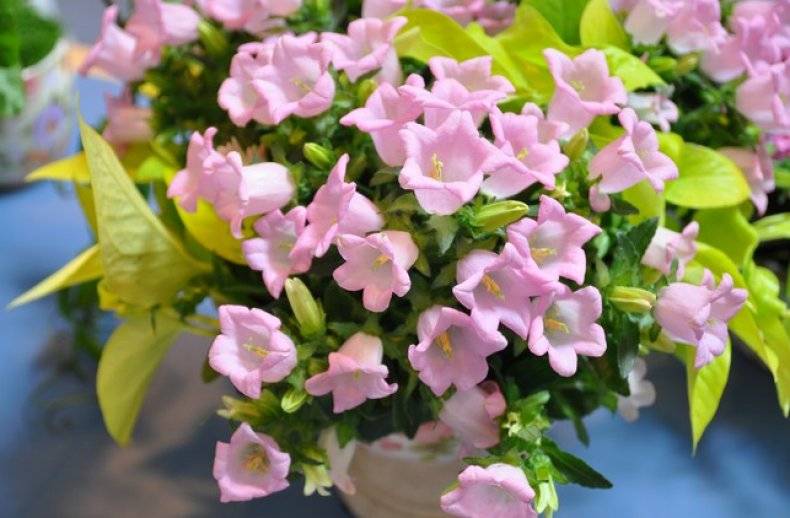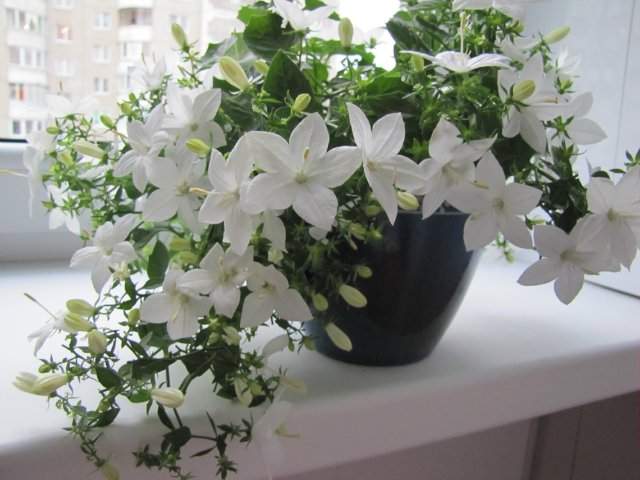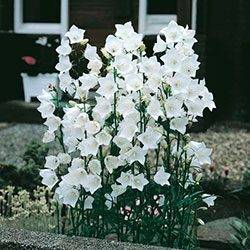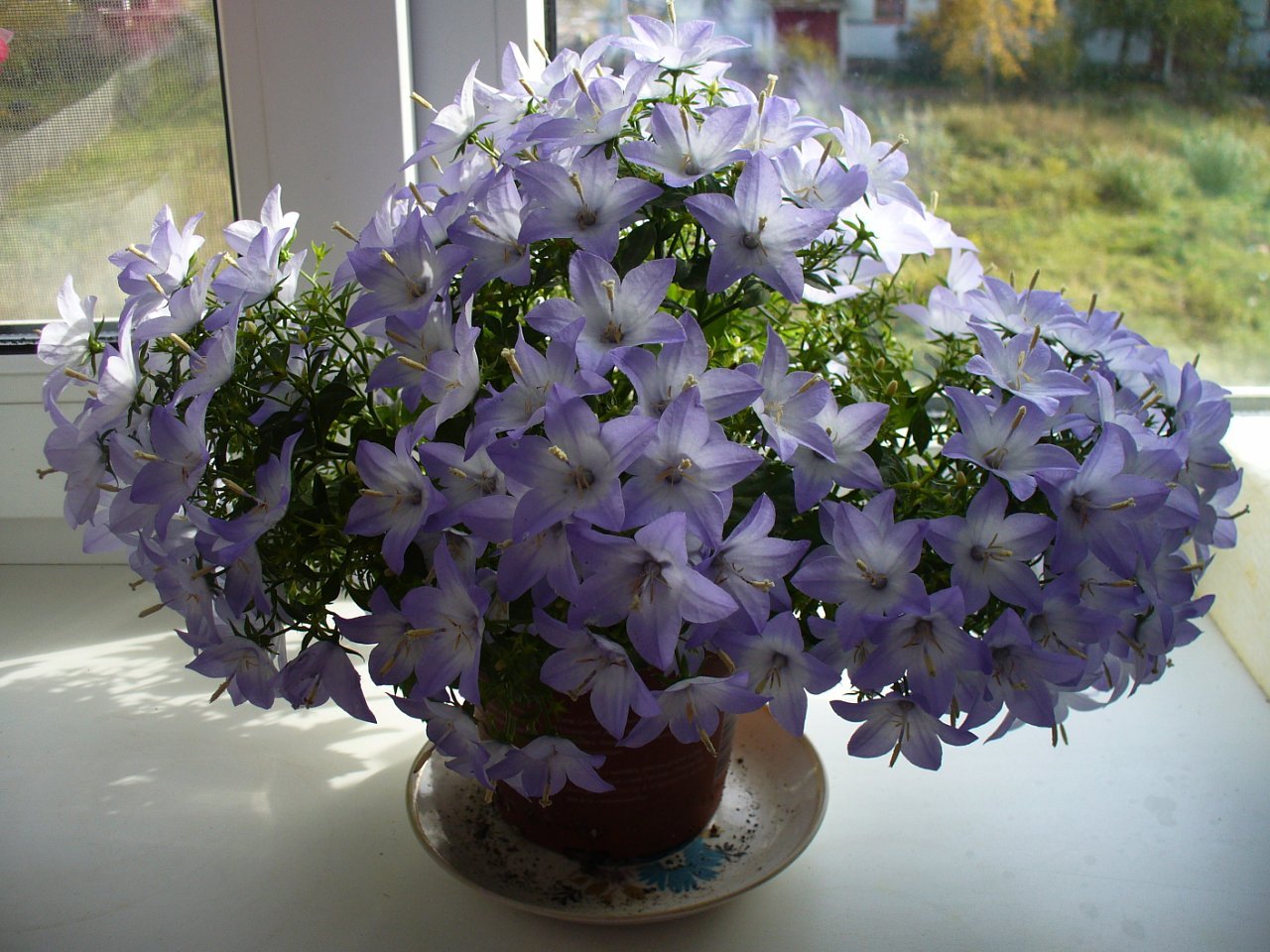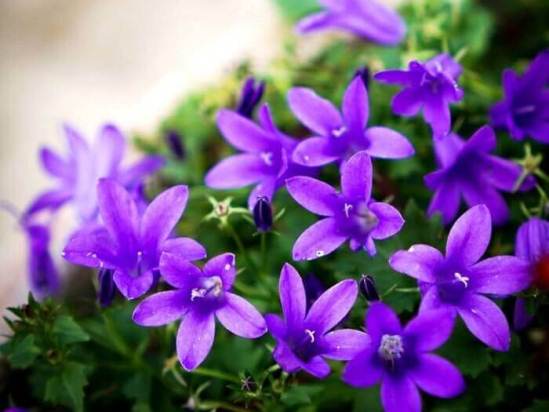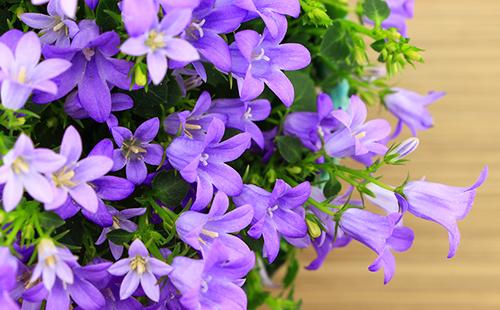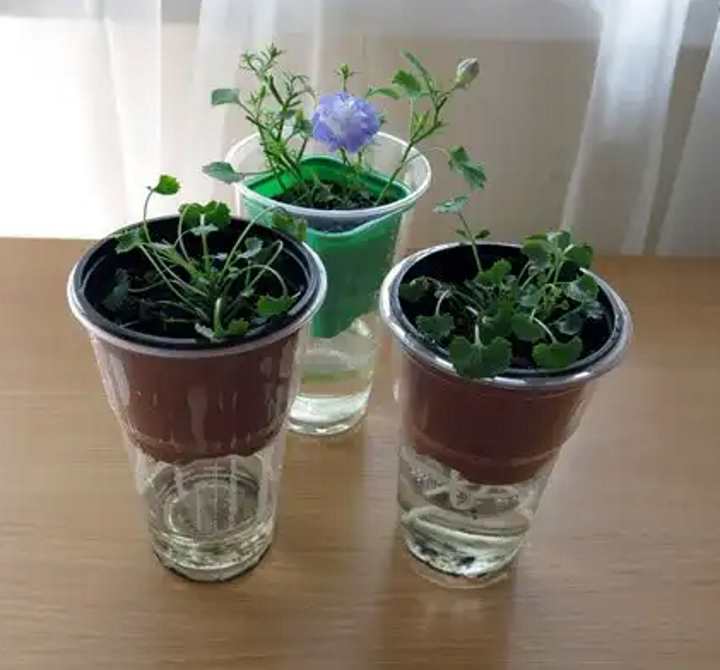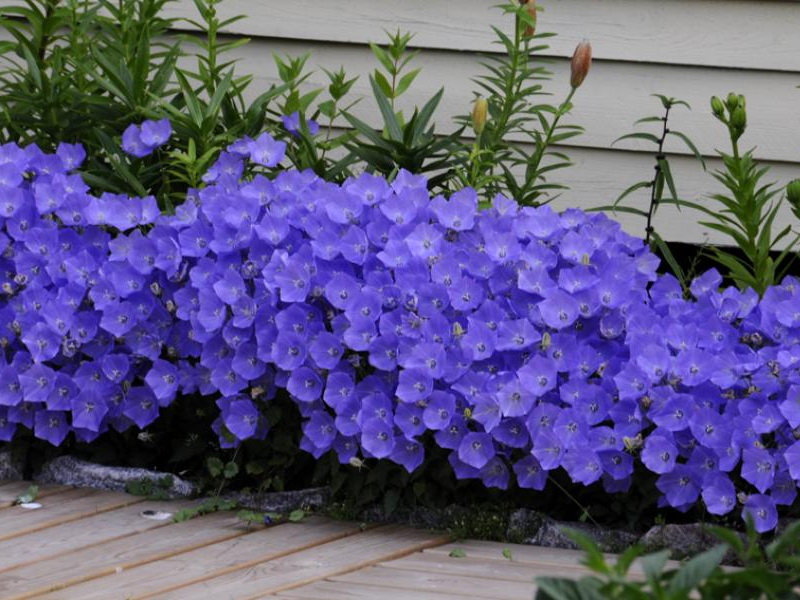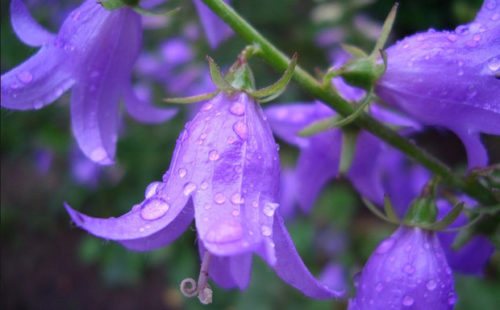Campanula care
Campanula is a herbaceous plant belonging to the bellflower family. The name in translation means "bell". Campanula is better known by the names "bride" or Alba with white flowers and "groom" or Maya with blue inflorescences. Another name for the bell is Shooting Star.
Homeland and appearance of campanula
Under natural conditions, Campanula grows in the Mediterranean. More than three hundred species prefer to grow in the mountainous regions of southern Europe, and in the gardens you can find no more than a hundred cultivated varieties of bells.
In indoor floriculture, there are mainly annuals, perennial species are rather rare. Each variety of Campanula is distinguished by its individual shape, palette and size. All bells are ampelous plants with stems hanging down. Campanula is best suited for indoor cultivation, the shoots of which reach a length of 25 cm and are densely strewn with flowers. The flowering period begins in spring and lasts until autumn. The “bride” plant has white inflorescences, while the “groom” has blue, blue or purple inflorescences.
The leaves are small, no more than 5 cm in diameter. The shape of the leaf plate is round or cordate, the edges are serrated. Each leaf is attached to the branches with a fragile petiole.
The bell is considered a non-capricious plant, grows well in cool rooms, in summer it feels great in the fresh air. Even in a dormant period, it does not need to be cared for in a certain way. The only unpleasant moment that a florist may encounter is the short period of the plant's life, however, and this is easy to cope with if you root cuttings cut from the mother bush in the spring.
Watering mode
The advantage of the plant is that you do not need to prepare water in a special way to water it. The plant tolerates watering with water and lime well. That is why ordinary tap water can be used for irrigation without settling it.
In the summer, you need to water the campanula abundantly so that the soil is always moist, but not wet. Do not allow moisture to stagnate in a flowerpot or pallet. In winter, watering is minimized.
Lighting requirements
When choosing a place to grow a bell, you should first of all focus not on the level of illumination, but on the presence of drafts. Even minor drafts from cracks in the windows can cause the death of the plant.
In order for the flowering to be abundant and long-lasting, it is better to choose light windows, otherwise the stems of the plant will be weak, the leaves are small, and there will be no flowers at all.
The best choice is east and west windows; on the south windows, the campanula should be protected from direct sunlight.
The bell does not like to be disturbed and turn the flowerpot around its axis.
Temperature regime
As a rule, campanula is not demanding on the air temperature. In summer, the optimal mode for her is from +22 to +25 degrees. In winter, during the dormant period, the temperature must be reduced to + 12- + 15 degrees.
Top dressing
Flowering requires a lot of effort from the plant, and therefore it is necessary during the period of active growth to regularly fertilize once every few weeks for flowering indoor plants. In addition, you can use dressings for Saintpaulias, but in this case, the concentration should be reduced by half in comparison with that indicated on the package.
How to take care of it properly?
In order for any houseplant to look beautiful and attract attention, it should be regularly and carefully looked after.Campanula can hardly be called a finicky flower when it comes to leaving, however, some points are still worth paying attention to.
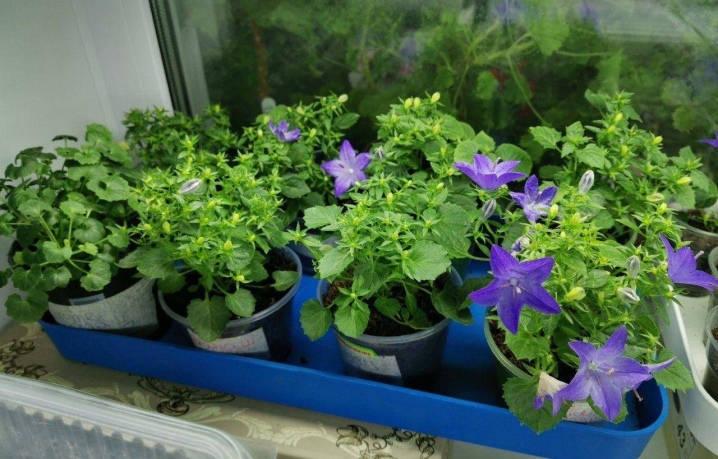
Watering
Campanula belongs to indoor plants that can do without moisture for a long time. In some cases, the bell can go without watering for up to 2 weeks, which is an indicator of the hardiness of some succulents.
Unfortunately, even despite such resistance to drought, Campanula is not able to maintain its beautiful appearance in the absence of moisture. That is why the owner of the flower needs to make sure that the soil in the pot always remains slightly moistened in the summer.
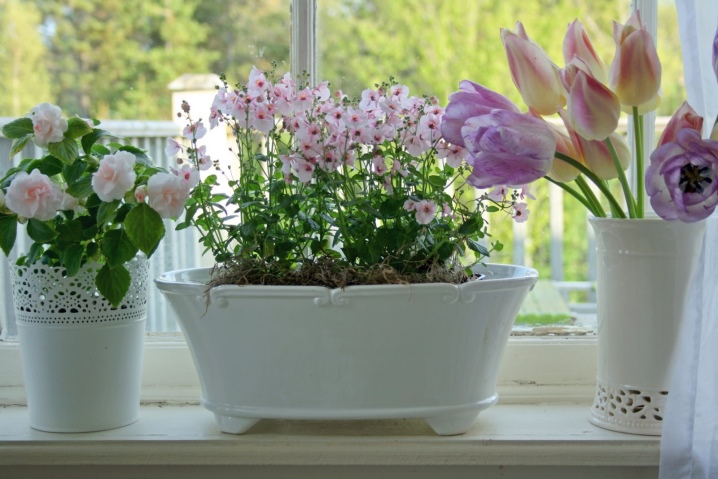
In the autumn and spring seasons, watering the campanula is advised to be reduced to several times a month, however, it is also not necessary to allow the soil in the flower pot to completely dry out. In winter, watering should also be carried out as the soil dries up, especially for flowers growing in well-heated rooms.
Watering can be carried out both under the roots themselves, and with the help of a sprayer. The latter should not be used during the summer season and during the flowering period - moisture on the flowers can provoke the appearance of rot or sunburn.

In no case should moisture stagnation in the pot at the campanula be allowed. Any water that has passed through the holes in the pot and the drainage layer should be removed immediately. In case of stagnation of moisture in the roots of the plant, the chance of rotting of the root system increases. So that moisture does not linger at the root collar of the flower, the soil must be thoroughly loosened before watering.
For watering, it is best to use settled soft tap water or rainwater.
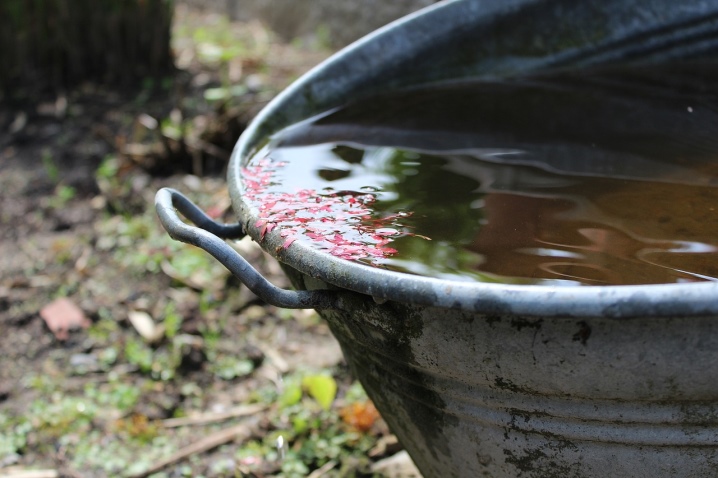
Top dressing
The need for additional feeding and fertilizers in campanula is manifested during the growing season and active growth. During this period, classical fertilizers for indoor plants with flowers must be added to the soil to the plant at least once every 2 weeks. In addition, the long and continuous flowering period, which can last up to several months, greatly weakens the plant and takes all the nutrients from the soil.
To fertilize campanula, classic vitamin complexes for home plants can be used. Best suited drugs "Rainbow", "Pocon", "Bona Forte", "Agricola".
Avoid feeding campanula in late autumn or winter - at this time the dormant period begins, when the plant will accumulate strength for flowering next year.
Bush formation
To maintain a pleasant and healthy campanula appearance, flower owners often resort to decorative pruning. Usually this procedure involves removing wilted buds and dry leaves, but may involve a process such as pinching. It involves the spring removal of the upper 2-3 leaves from the shoots of the plant, after about a month the same procedure is carried out with the side leaves.
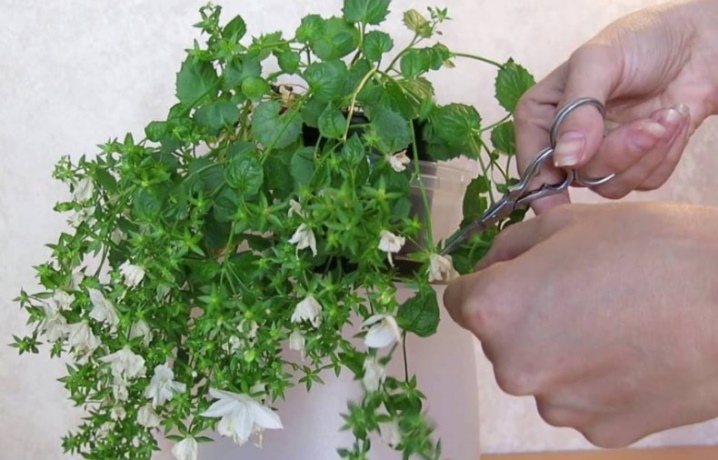
Dormant period
In late spring and winter, that is, during the dormant period of campanula, the plant should be placed in a cool room with good natural light, and the amount of watering should be reduced to 3 times a month. The best place for this would be a glazed balcony or loggia.
When preparing the campanula for the dormant period, all shoots of the plant must be shortened to a length of 12 cm.It will also be useful to cut off all dry leaves from the plant and remove the fallen leaves from the pot - it is dry leaves that often become sources of infection by pests or fungi.

How the plant reproduces
A home bell is quite simple to grow from seeds, propagate by cuttings or by dividing a bush. In order not to lose the plant when its life comes to an end, new shoots are obtained from it and grown again. Consider how to breed campanula at home in convenient ways.
Due to their beautiful appearance and ease of maintenance, bells are often used when creating gift compositions, as well as as a decoration for events.
Seeds
The most popular method for breeding bells is from seed.Campanula seeds germinate rather quickly and do not require special care. This method allows you to plant flowers of different shades, and not propagate existing plants.
How to grow bells at home from seeds?
- Prepare plastic cups with soil;
- Sow the seeds in a shallow depression above the ground;
- Place a few seeds in a glass to ensure the germination of flowers;
- Spray the soil from a spray bottle periodically, being careful not to flood it;
- When the seeds germinate and the shoots produce at least three leaves, they can be transplanted into separate pots.
When planting bells from seeds, follow the instructions on the package. Some varieties may require preliminary soaking in water and other preparatory measures.
Cuttings
Campanula can be bred by cuttings - cut leaves quickly give new shoots. The procedure must be performed in several stages:
- Cut off the shoot from the bottom of the plant, with two or more leaves;
- Place the stem of the cutting in a glass with a weak solution of potassium permanganate for half an hour - this will disinfect the cut site;
- Place the cuttings in a container with clean filtered water and wait for the roots to appear;
- Prepare the soil and cups for planting cuttings;
- Cuttings with emerging roots must be placed in the ground to a depth of 2-3 cm and made stable;
- If possible, make a "greenhouse" for the cuttings from cling film;
- Young shoots do not need to be poured with water - spray the foliage and soil surface with a spray bottle;
- Wait until a few new leaves appear on the plant (3-4 weeks after planting) and transplant it into a permanent pot.
Campanula cuttings and young shoots from seeds can be planted both in different cups and in one large container. In the first case, it will be easier to separate them from each other, and in the second, it will be more convenient to organize a greenhouse.
Dividing the bush
House bells quickly restore damaged roots and shoots, so one of the ways to reproduce them is to divide the bush. This method is used mainly for adults, overgrown plants, when they feel cramped in the pot.
To divide the bush, you need to follow this plan:
- Gently remove the campanula from the pot and free the roots from the adhering soil;
- Rinse the root system under running water;
- With a clean and sharp knife blade, divide the roots into two equal parts;
- The cut sites can be treated with potassium permanganate or other antiseptic, but this is not required;
- Place the bells in separate pots and place them in a shaded area.
The best types and varieties of campanula with photos and names
More than 300 species of campanula live in the natural environment (of course, not all are cultivated). Through the efforts of breeders, many varieties have been obtained, which added a wide variety.
Campanula isophylla Campanula isophylla
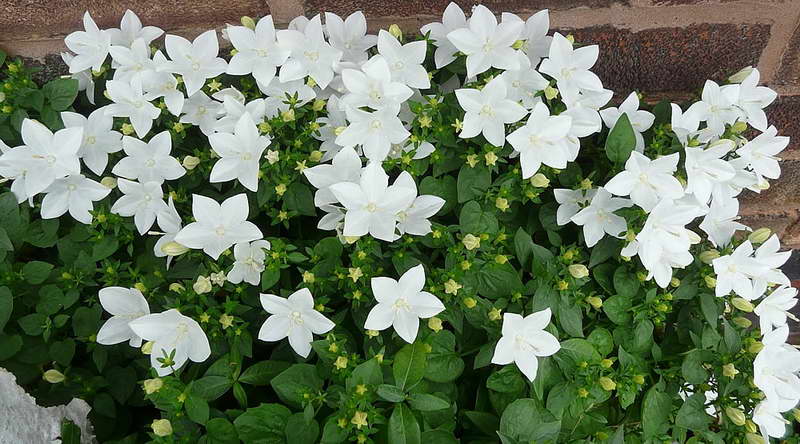
Campanula isophylla Campanula isophylla photo
A plant with drooping shoots 30 cm long. Leaves are rounded with almost even edges. The leaf plates are attached on long petioles. Corollas with a diameter of 4 cm. This species became the basis for breeding varieties Alba with white flowers and Mayi - flowers with a blue tint, the notorious bride and groom.
Campanula carpathian Campanula carpаtica
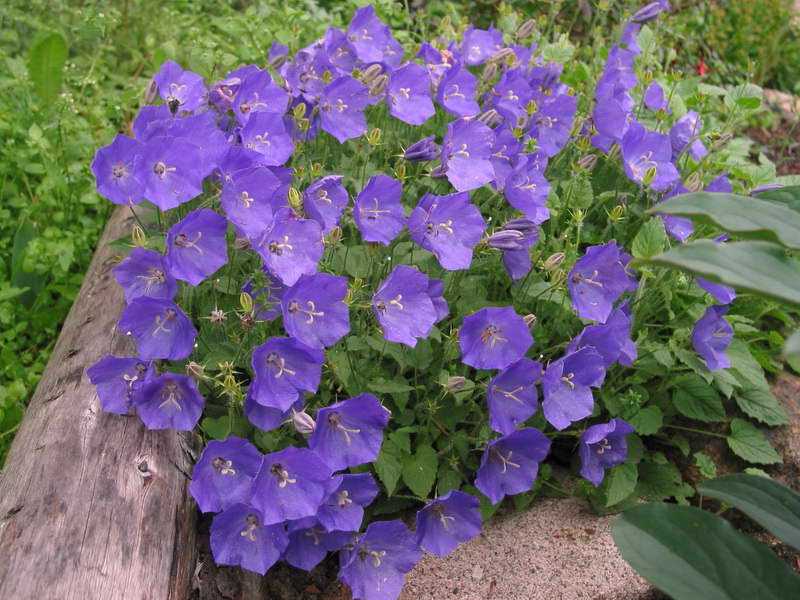
Campanula carpathian Campanula carpаtica photo
The length of the shoots does not exceed 30 cm. The rounded leaves are collected in a basal rosette, the stem leaves are short-petiolate, obovate in shape. Blooms all summer. Flowers of white, lilac or blue hue are 4-5 cm in diameter.
Campanula Pozharsky Campanula poscharskyana
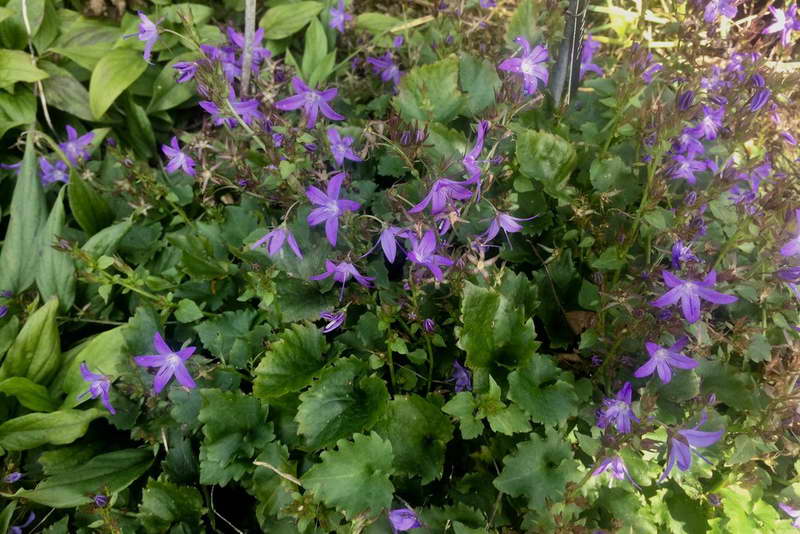
Campanula Pozharsky Campanula poscharskyana photo
Creeping shoots, 10-30 cm long. The diameter of the flower is 2-2.5 cm. The petals are narrower and thinner, the shade of the flower is bright purple. The plant grows well in the shade and tolerates cold normally (can be grown outdoors).
Campanula cultivar Pozharsky Blaurank
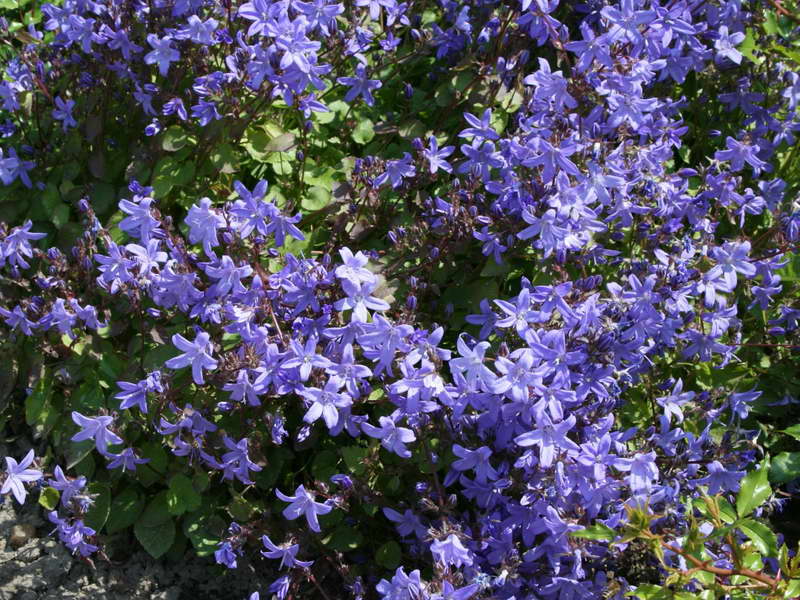
Campanula Pozharsky Blaurank Campanula poscharskyana ‘Blauranke’ photo
The height of the plant does not exceed 20 cm, while the leaves and flowers are larger than those of other species. Corolla diameter is 5-6 cm, flower shade is pastel blue.
Campanula medium Campanula medium

Campanula medium Campanula medium photo
Reaches a height of 60-80 cm, is a biennial: in the first year only basal rosettes of leaves appear, in the second year the stem develops and flowers appear.
The stem is straight, strong, reddish brown and bristly. The basal leaves are chased and lanceolate to elliptical and 12-15 cm in length with a jagged leaf margin. The upper leaves are smaller, lanceolate and sessile, almost covering the stem.
Flowers are collected in inflorescences of extremely durable flowers. They are attractive bell-shaped large flowers, hermaphroditic or self-pollinated, with varying shades of violet-blue or rarely white. The corolla has five lobes with slightly curved lobes (known as the coronary flower type). The flowering period lasts from May to July. The seeds ripen from August to September and are dispersed only by gravity.
Campanula portenschlagiana
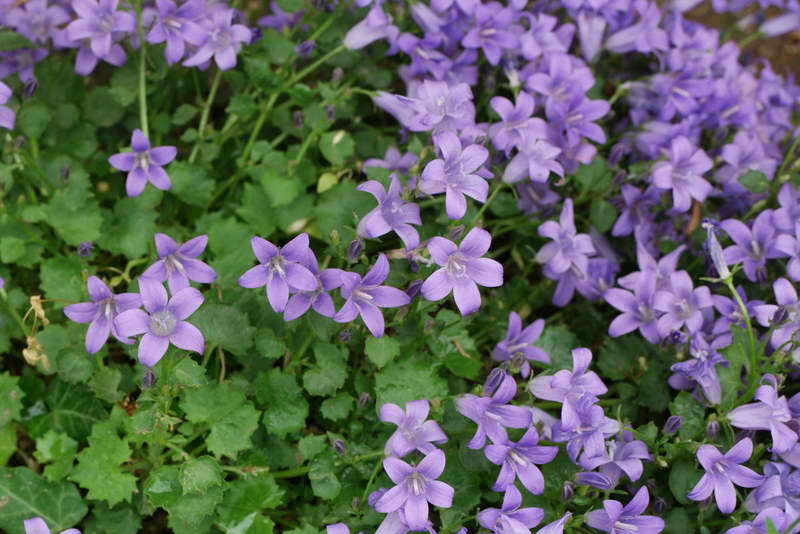
Campanula portenschlagiana Campanula portenschlagiana photo
Compact bushes 15 cm high. Heart-shaped leaf plates. Decorativeness is not lost even during the dormant period - old shoots dry out by spring. Blooms from May to early September. The shade of flowers is lilac.
Campanula garganica Campanula garganica
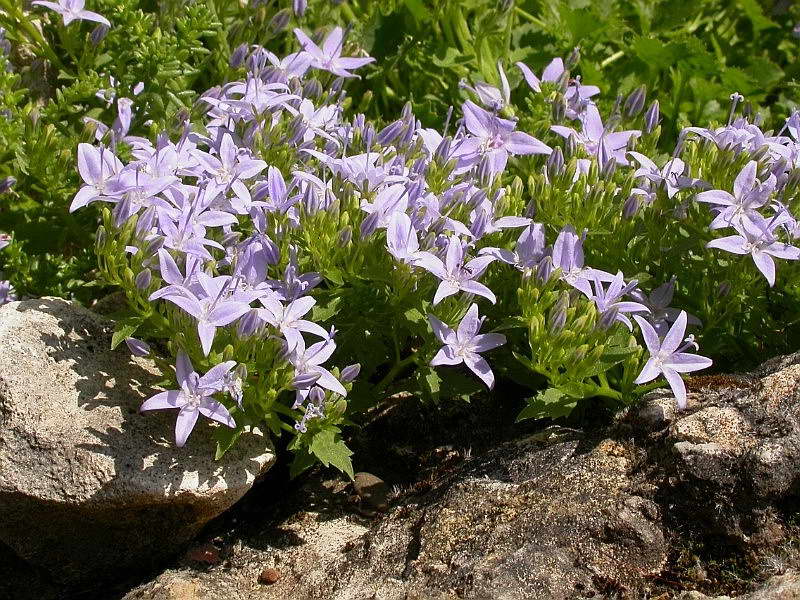
Campanula garganica Campanula garganica photo
Creeping stems reach a length of 15 cm. The diameter of the flower is 5 cm, they impress with a bright blue hue. Flowering lasts all summer.

Campanula alpine Campanula alpestris photo
The crumb is only 5-10 cm high. Flowers are of a bright blue hue.
Campanula spoon-leaved Campanula cochleariifolia

Campanula spoon-leaved Campanula cochleariifolia photo
Plant height is 15-20 cm. The leaves are small (3-5 cm long) bent in the shape of a spoon. The flowers are snow-white or bright blue.
Campanula terry Campanula gemina

Campanula terry Campanula gemina photo
A hybrid derived from the species Campanula spoon-leaved and Carpathian. Carved sheet plates are densely arranged. Terry flowers, white, blue, violet.
A series of mini-hybrids is represented by the varieties White Bali, Blue Bali, White Wonder, Blue Wonder.
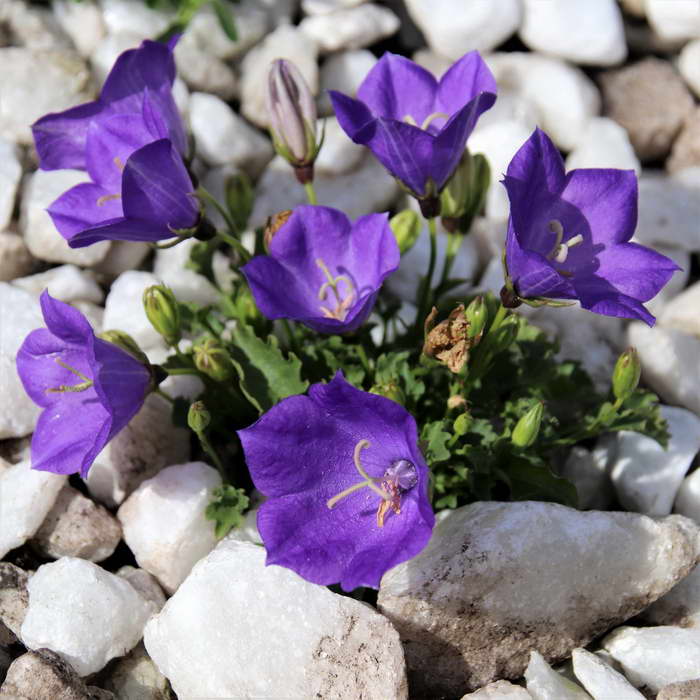
What does a campanula photo look like?
How can you multiply?
Some gardeners prefer to propagate Campanula on their own, rather than buying ready-made young plants that were grown in unknown conditions. For propagation of campanula, 3 methods are usually used: cuttings, dividing a bush or growing from seeds.
Cuttings
Usually cuttings are carried out in October - November. The cuttings themselves can be easily obtained with standard preventive pruning prior to dormancy.
- The safest and fastest way is to root the lower part of the shoot, which has its own full-fledged "heel" with young roots. In addition to its root system, such an shoot must have at least 3 full leaves.
- In order to stimulate the growth of the root system and help the cuttings quickly get used to a new place, its heel is placed in a container with a solution of potassium permanganate or "Fitosporin" for half an hour (5 ml per 1 liter of water will be enough).
- After that, the plant is placed in a container with water, where you also need to add one tablet of ordinary activated carbon (you can also add a little succinic acid).
- For planting campanula cuttings, wide and deep containers are prepared with a mixture of peat and sand in equal quantities. The cuttings are planted in the ground to a depth of no more than 3 cm, while maintaining a minimum distance between the shoots.
- To create a pleasant microclimate in the container, cover it with transparent film or glass, and ventilate it regularly. For the growth of healthy and strong roots, the temperature in the room should not drop below 24 degrees. Lighting should be bright, but not direct - therefore, cuttings do not need to be placed directly under the sun's rays.
- After about a month, after the cuttings have taken root, they should be planted in separate containers.As soon as the cuttings are accepted, and their shoots grow by 7-10 cm, you can pinch, which stimulates the growth of additional lateral shoots.
Dividing the bush
Experienced growers usually divide the bush during the campanula transplant. To propagate the plant in this way, you need to divide the herbal ball of the bell into shoots with their own root system. Unfortunately, Campanula has extremely dense and tangled roots that are usually difficult to untangle.
So that the cut parts of the roots do not rot and can take root in a new place, the cut points must be processed with crushed chalk or cinnamon. After this treatment, the separated plants are planted in separate pots, where they undergo standard care. To make it easier for the plant to get used to the new place, it should be watered immediately after planting, and a week after that, fertilized.
Seeds
The process of growing bell seeds takes a very long time - up to 1 year. Its most basic stages should be considered in more detail.
- For planting seeds, flat polymer or wooden containers are usually chosen. It is better to use leafy soil or a mixture of sand and peat as a soil or substrate.
- The containers are filled with soil, after which the soil is leveled and thoroughly moistened.
- Campanula seeds are evenly distributed over the container and lightly sprinkled with sand on top, after which they are moistened again with a sprayer.
- In order to maintain a favorable microclimate in the containers, they are covered with foil or glass. Condensation, which will often form on the inside of the film, must be removed regularly. In addition, the containers should be ventilated.
- To stimulate plant growth, the soil can be sprayed with a rooting stimulant.
- The room where the containers with seeds are located should have a temperature of 22-24 degrees, as well as good natural light.
- If you did everything correctly, then the first shoots of campanula will appear in a week. As soon as they have their own leaves (at least 3), a pick is carried out. Plants are planted in separate cups or pots, where they undergo standard care.
Potential problems during cultivation
How sad that even such a delicate flower can suffer from fungal diseases. They often appear due to improper watering. In addition, the scale insect and spider mite sometimes settle on the campanula. It is not always easy to notice them, so all parts of the plant are regularly examined. If pests are identified, the leaves and shoots are washed under a stream of warm water or treated with a special substance.
Often it causes panic in many if the campanula dries up. What to do in such a situation? First, they try to determine the cause. It could be poor lighting or dry air. Having eliminated these problems, the flower will regain its magnificent "forms".
In some cases, the question arises: why campanula does not bloom, despite proper care.
However, there are a few rules to keep in mind:
- the flower should not be touched during the growing season;
- in early spring, the plant needs to be fed;
- during flowering, campanula needs sufficient lighting.
Violation of these conditions leads to a slowdown in flower growth. As you can see, with proper care, the campanula will definitely decorate the living space with graceful bells of different colors. Why not grow such a miniature pleasure garden?
Caring for garden bells
How to care for bells
Growing bells is no different from growing any other garden flowers - bells are unpretentious. They are watered only when a prolonged heat and dryness is established. After watering, it is convenient to loosen the soil around the flowers and remove weeds. Tall bells are tied to a support as needed. Bells are fed for the first time in spring, through melted snow, with nitrogen fertilizer.The second feeding with complex fertilizer is carried out in the first half of summer, at the beginning of budding. To prolong the flowering of bells, remove wilted flowers in a timely manner.
Reproduction of bells
Annual bells reproduce by seeds, biennial ones - by seeds and spring cuttings. Perennial bells can be propagated by root cuttings, parts of the rhizome, dividing the bush and stolons, since they do not always retain varietal characteristics during seed propagation. Terry varieties of bells do not set seeds, so they are propagated exclusively by vegetative methods.
Perennial species of bells with carpal or tap root systems are considered vegetatively immobile and propagate by seeds. Those species with a short rhizome are considered vegetatively sedentary - they are propagated by division and cuttings. Species with long creeping rhizomes, which reproduce both by seeds, division and cuttings, and by rhizome segments and root suckers, are considered vegetatively mobile.
We described the seed seed propagation method for you, but you can sow seeds in mid-October directly into the ground, where they will naturally stratify during the winter months and grow together in the spring, and you just have to plant the seedlings. You can sow seeds in the ground in May, but then they need to be stratified for two months in a vegetable box of the refrigerator, and since annual bells reproduce well by self-sowing, is it worth it to complicate your life by stratifying seeds?
Bells cuttings are harvested in spring, in March-April - they are cut from young stem or basal shoots, planted in a light loose substrate and placed under a film dome to create high air humidity. It is best to use a greenhouse and a special mist sprayer for this purpose. Root regrowth in cuttings occurs within three to four weeks.
The division of the bush is carried out in the third or fifth year of the plant's life, but some species can be divided into the second year. At the beginning of May or at the end of summer, large bushes are dug up and, having cut off the stems, they are divided into parts with a sharp sterile knife, each of which should have developed roots and renewal buds, after which the sections are processed with crushed coal and the cuttings are immediately planted in a permanent place.
When propagating by parts of the rhizome, they dig out the creeping root of the plant, divide it into parts so that there are renewal buds in each segment, and planted in the ground so that the buds are at the level of the soil surface.
Root offspring must be separated from the mother plant and immediately transplanted to a permanent place.
Bellflower pests and diseases
Blossoming bells look very cute, but this is not the only merit of flowers. They are so unpretentious that planting and caring for the bell is a pleasure and does not require time and effort.
Bells are immune to diseases and pests and are very rarely affected by them, however, when flowers are grown for many years in one place, pathogenic microorganisms - fusarium, sclerotinia or botrytis - accumulate in the soil, which can lead to the death of the plant. To prevent this from happening, twice a season, in spring and autumn, treat the bells with a 0.2% Fundazole solution.
In humid weather, a slobbering penny may appear on the bells, which is expelled with an infusion of garlic. Low-growing bells can be damaged by slugs, from which plants are sprayed with a decoction of hot pepper and superphosphate granules are scattered under the flowers.
Home cultivars
Campanula is commonly used in landscaping, but some varieties are suitable for home cultivation. The following varieties are considered the easiest to care for:
I. Equivalent Campanula
A plant grown in ampelous form - its shoots hang under their own weight. It blooms with white and blue flowers, has small leaves.
II. Campanula Carpathian
A perennial variety of bluebells. Differs in a rounded shape of leaves and a wide variety of shades of flowers. Forms a rounded beanie. It blooms throughout the summer, then a dormant period begins.
III. Campanula Blauranca
This variety emit large flowers and leaves, while the bush itself does not grow higher than 20 cm. Flowers, as a rule, are blue in color.
Terry campanula also belongs to the varieties that are bred at home, however, it is very demanding to care for. This variety is distinguished by special "double" flowers from several rows of petals.

